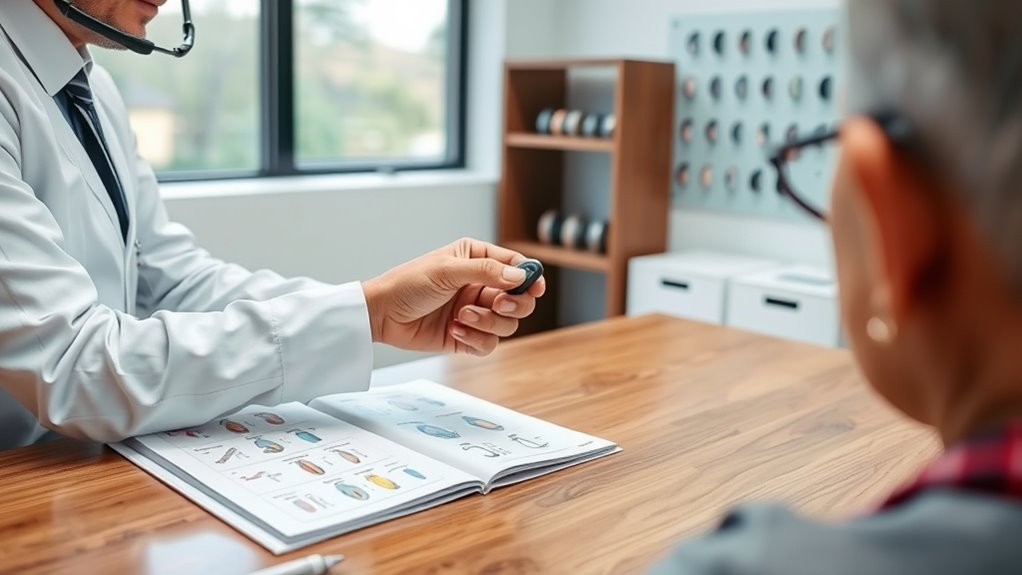A hearing aid orientation program should cover device maintenance, troubleshooting skills, and understanding features. You’ll learn daily cleaning routines, how to replace batteries, and check for debris or damage. It also includes adjusting sound programs, volume, and connectivity options like Bluetooth. Being aware of environmental factors and managing expectations is essential. Continuing will help you discover expert tips to optimize your hearing aid care and performance for long-term benefits.
Key Takeaways
- Comprehensive device maintenance, including daily cleaning, earwax checks, and proper storage practices.
- Troubleshooting skills for common issues like whistling, battery replacement, and device reset procedures.
- Familiarity with device features such as sound programs, volume controls, and connectivity options like Bluetooth.
- Setting realistic expectations, emphasizing routine check-ups, cleaning, and ongoing support for optimal use.
- Education on environmental factors affecting hearing health and device performance, promoting overall device care and longevity.

Have you ever wondered how to get the most out of your hearing aids? When you attend a hearing aid orientation program, you’re taking a pivotal step toward maximizing their benefits. A thorough program should cover more than just how to wear your devices; it should equip you with the knowledge to maintain and troubleshoot them effectively. Proper device maintenance is key to guaranteeing your hearing aids work efficiently over time. During the session, you’ll learn simple routines like cleaning your devices daily, checking for earwax buildup, and storing them safely when not in use. These small habits can greatly extend the lifespan of your hearing aids and help prevent common issues.
Attending a hearing aid orientation helps you learn maintenance routines to extend device lifespan and prevent issues.
Troubleshooting tips are equally essential. Sometimes, you might notice a whistling sound, reduced volume, or intermittent sound. Instead of panicking or rushing to your audiologist, knowing basic troubleshooting steps can save you time and frustration. Your orientation should teach you how to replace batteries, guarantee the devices are correctly seated, and perform quick checks for any visible damage or debris. You might also learn how to reset your hearing aids if they stop responding or if you experience connectivity issues. Having these skills gives you a sense of independence, so you’re not left unsure when minor problems occur.
In addition to device care, a good orientation program will guide you through understanding your hearing aids’ features. Modern devices often come with different sound programs, volume controls, and connectivity options like Bluetooth. Learning how to adjust these settings confidently allows you to personalize your hearing experience. This part of the program should include hands-on practice, so you feel comfortable making adjustments on your own. Knowing how to operate your hearing aids thoroughly can improve your overall satisfaction and help you adapt more quickly to using them daily.
Another essential aspect of the orientation is education on realistic expectations and ongoing support. Hearing aids aren’t magic cures; they require patience and regular care. Your program should emphasize the importance of routine check-ups, cleaning schedules, and staying aware of your hearing health. It’s also beneficial if the program offers resources or contacts for troubleshooting questions that may arise after the initial training. This ongoing support ensures you don’t feel stranded if issues develop later on. Additionally, understanding that air quality can affect your hearing health underscores the importance of a clean and healthy environment for optimal device performance.
Frequently Asked Questions
How Often Should I Revisit My Hearing Aid Orientation?
You should revisit your hearing aid orientation regularly, ideally every six months, to stay updated on your maintenance schedule and troubleshooting tips. Frequent check-ins help guarantee your device functions properly and lasts longer. If you notice issues or changes in sound quality, don’t wait—reach out sooner. Regular reviews help you stay confident in using your hearing aids effectively, making sure you’re getting the best possible hearing experience every time.
Can Orientation Programs Be Customized for Specific Hearing Losses?
Imagine stepping into a world where your hearing aid journey feels uniquely yours. Yes, orientation programs can be personalized for your specific hearing loss, offering customized training and tailored instructions. This guarantees you’re not just learning general tips but mastering how to optimize your device for your needs. With this tailored approach, you gain confidence, clarity, and a deeper connection to the sounds you’ve been missing.
Are There Virtual or Online Hearing Aid Orientation Options?
You can find virtual training and online resources that offer extensive hearing aid orientation options. These programs provide convenient access to tutorials, troubleshooting guides, and device setup instructions from the comfort of your home. Many vendors and audiologists now offer online videos, interactive modules, and live virtual sessions, making it easier to learn about your hearing aids. This flexibility helps you gain confidence and maximize your device’s benefits quickly.
What Support Is Available if I Encounter Issues After the Program?
If you encounter issues after your hearing aid orientation, you have options for support. You can access troubleshooting resources online or through your provider’s website. Peer support groups also offer valuable advice and shared experiences. Additionally, many clinics provide follow-up appointments or helplines, ensuring you get timely help. Don’t hesitate to reach out—these resources are there to help you troubleshoot and smoothly adjust to your hearing aids.
How Long Does a Typical Hearing Aid Orientation Session Last?
Think of a hearing aid orientation as a brief voyage, typically lasting about an hour. During this time, you’ll navigate through essential skills like hearing aid maintenance and device troubleshooting, ensuring your device works seamlessly. This session is designed to be concise yet all-encompassing, giving you the tools to confidently manage your hearing aids daily. Most programs keep it engaging and focused, so you leave feeling prepared and empowered.
Conclusion
Remember, a well-designed hearing aid orientation is your key to confidence and clarity. By understanding your device and practicing regularly, you’ll open its full potential. Think of it as planting a seed—you nurture it with patience and care, and soon it blossoms into better hearing and improved quality of life. So, stay committed, ask questions, and embrace the journey—because with the right guidance, every step leads to clearer, richer sound.











